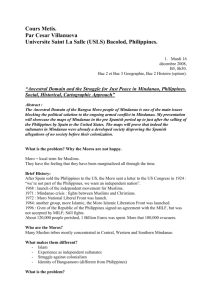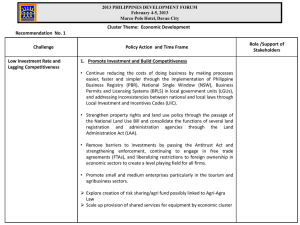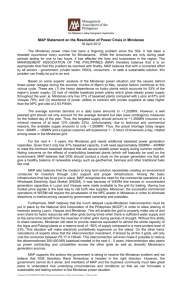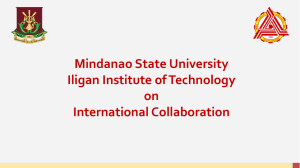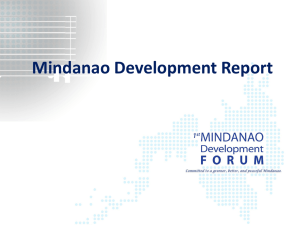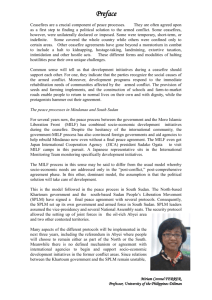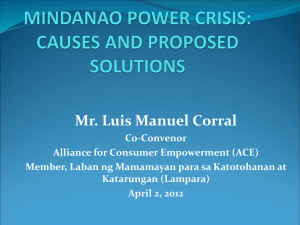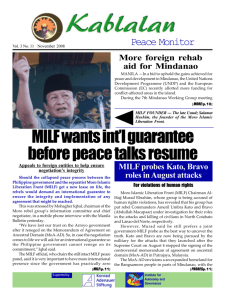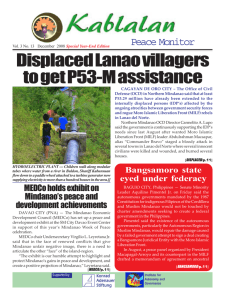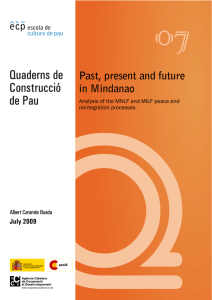Reflections on Public Participation in Peace Processes in Mindanao
advertisement
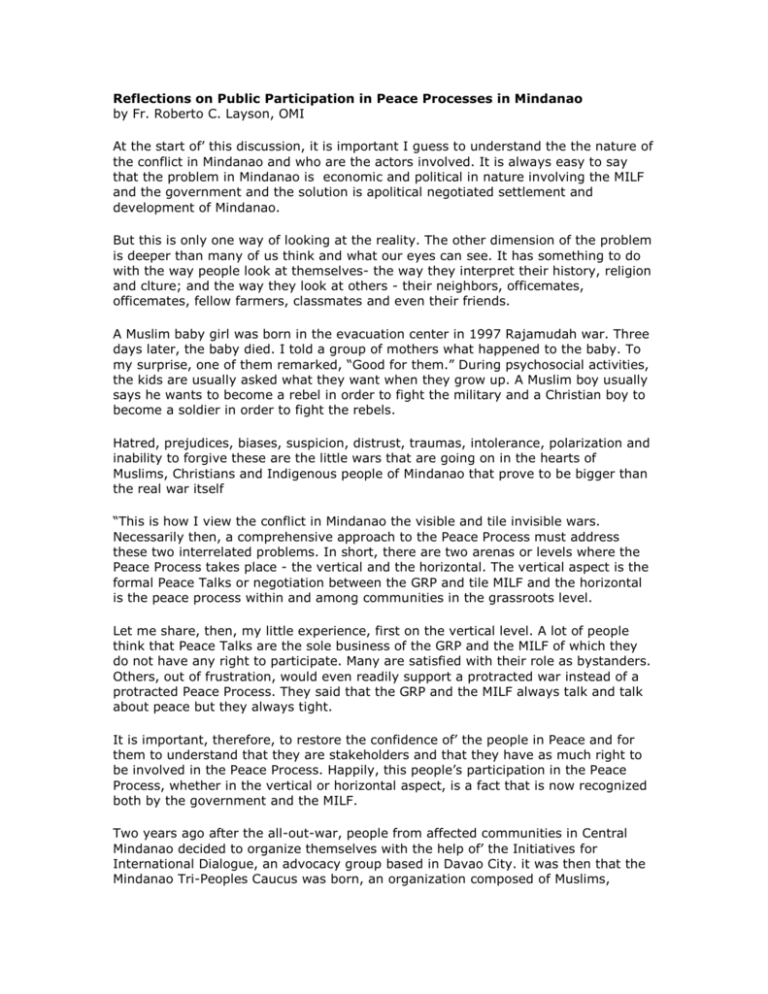
Reflections on Public Participation in Peace Processes in Mindanao by Fr. Roberto C. Layson, OMI At the start of’ this discussion, it is important I guess to understand the the nature of the conflict in Mindanao and who are the actors involved. It is always easy to say that the problem in Mindanao is economic and political in nature involving the MILF and the government and the solution is apolitical negotiated settlement and development of Mindanao. But this is only one way of looking at the reality. The other dimension of the problem is deeper than many of us think and what our eyes can see. It has something to do with the way people look at themselves- the way they interpret their history, religion and clture; and the way they look at others - their neighbors, officemates, officemates, fellow farmers, classmates and even their friends. A Muslim baby girl was born in the evacuation center in 1997 Rajamudah war. Three days later, the baby died. I told a group of mothers what happened to the baby. To my surprise, one of them remarked, “Good for them.” During psychosocial activities, the kids are usually asked what they want when they grow up. A Muslim boy usually says he wants to become a rebel in order to fight the military and a Christian boy to become a soldier in order to fight the rebels. Hatred, prejudices, biases, suspicion, distrust, traumas, intolerance, polarization and inability to forgive these are the little wars that are going on in the hearts of Muslims, Christians and Indigenous people of Mindanao that prove to be bigger than the real war itself “This is how I view the conflict in Mindanao the visible and tile invisible wars. Necessarily then, a comprehensive approach to the Peace Process must address these two interrelated problems. In short, there are two arenas or levels where the Peace Process takes place - the vertical and the horizontal. The vertical aspect is the formal Peace Talks or negotiation between the GRP and tile MILF and the horizontal is the peace process within and among communities in the grassroots level. Let me share, then, my little experience, first on the vertical level. A lot of people think that Peace Talks are the sole business of the GRP and the MILF of which they do not have any right to participate. Many are satisfied with their role as bystanders. Others, out of frustration, would even readily support a protracted war instead of a protracted Peace Process. They said that the GRP and the MILF always talk and talk about peace but they always tight. It is important, therefore, to restore the confidence of’ the people in Peace and for them to understand that they are stakeholders and that they have as much right to be involved in the Peace Process. Happily, this people’s participation in the Peace Process, whether in the vertical or horizontal aspect, is a fact that is now recognized both by the government and the MILF. Two years ago after the all-out-war, people from affected communities in Central Mindanao decided to organize themselves with the help of’ the Initiatives for International Dialogue, an advocacy group based in Davao City. it was then that the Mindanao Tri-Peoples Caucus was born, an organization composed of Muslims, Christians and Lumads from grassroots comnmuinities. The group decided to support the Peace Process both in the vertical and horizontal level. Since MPC has acquired accreditation with an observer status from the GRP and the MILE, it had sent observers to Kuaha Lumnpur in Malaysia during the formal Peace Talks on two occasions. The group also sent position papers to tile GRP and MILE, providing analysis, ideas and alternative mechanisms to sustain the Peace Process. The group has gone as far as engaging the two panels in a round table discussion on certain issues and succeeded in lobbying for the inclusion of one IP representative to the technical committee. On several occasions, MPC has also sent representatives to the meetings of the Coordinating Committee on the Cessation of Hostilities or CCCH. The same group also participated in monitoring ceasefire agreement along with other peace groups. So far, two Monitoring Missions were conducted -- one in January amid one in July after the Buliok incident. Reports of these missions were presented and discussed with the two panels, the military establishment and MILF Central Commnittee. Surprisingly, these reports were readily accepted by the government and the MILF. In fact, they were generous in saying that they were grateful for the role of the civil society in tile Peace Process. On one occasion, Lt. General Rodolfo Garcia, now head of’ the CCCH on the government side, made an honest remark of the group’s findings when we met them at Camp Aguinaldo, “We find your report objective. It is true that some of our soldiers on the ground may have committed human rights violations. As you know, the military is not a perfect organization. We’ll try our best to hook into these reported violations.” Precisely, we are involved in the Peace Talks because we know that the military is not a perfect organization. Neither the MILE, we found out.” Last February, at the height of’ violence, MILF forces harassed two civilian communities in Pikit. I immediately wrote a letter of complaint to Al Hadj Murad, the chief of’staff of the Bangsamoro Islamic Armed Forces. He responded my letter saying, “The MILE conducted an investigation amid the initial findings show that the MILF, on the basis of’ command responsibility, is either guilty of’ omission or commission.” He said that, “those who committed anti-Islamic or anti- people activities such as robberies, lootings and the like have penetrated the ranks of our freedom fighters.” “It is for this reason,” he said, “that through you, we are hereby offering apology to where it is due for whatever excesses committed by members our freedom fighters of’ the Moro Islamic Liberation Front.” The lesson I learned in these two incidents is that there are better results if we are dialogical in our approach rather than confrontational. The former is pro-active while the later is reactive. Education plays a very important role in mobilizing people. Education of their rights is a source of power. It is this belief of their right to have a say in the Peace Process that brought ‘bakwits’ last April 4-12 face to face with the decision makers in Manila in what was called “Bakwit sa Siyudad.” ‘The delegates had dialogues with President Gloria Macapagal-Arroyo, former Sec. Angelo Reyes and his staff in the Defense Department, Senator Nene Pimnentel, other government agencies and support groups. It is this same conviction that brought tile bakwits to the highways of’ Pikit, Pagalungan and Pagagawan in June 25-26. Dubbed as “Bakwit Power”, about 8,000 evacuees went out of’ their makeshift tents. They occupied half of the CotabatoDavao National Highway, amid appealed to the government and the MILE to declare a ceasefire amid return to the negotiating table. But if there is going to be a real participation of the people in the Peace Process, then, both the government and the MILE must observe transparency. We cannot condone tile back-channeling approach that leaves many of us in confusion. The public must assert their right to know and to be informed regarding what the GRP and MILF talked in private. Last September 13, the ‘bakwits’ had a dialogue with government and military officials in Pagalungan and Pagagawan. The complained about lack of transparency on the part of the government in the implementation of rehabilitation projects and lack of religious and cultural sensitivity on the part of the military. It was a fruitful dialogue. As a result, several mechanisms were agreed upon that would improve tile situation. There are also other movements in Mindanao supporting other peace processes like the Federal Movement and the Movemnent for Referendum. These are movements that offer alternative peaceful solutions to tile Mindanao conflict. Women and children are natural peacemakers. Most of the time they don’t carry guns but they bear the brunt of the effects of war. They should speak more often in public and their voices be heard. Now, let me stress at this point that while a political negotiated settlement is certainly one of the solutions in resolving the Mindanao conflict, it is not the only solution. In fact, Peace Agreements may create a conducive space but they are not a guarantee that there will be instant peace in our communities. A lot of work will have to be done in the grassroots level. I remember a few years ago the statement made by a farmer which he said said, “People conflict. The conflict comes from the people. In the same way, people create peace and therefore peace must come from the people.” The problem in Mindanao is deep-seated. We do not have to go far to find indications. One only needs to listen with the way members of our timely talk about the Muslims or the Christians or the Lumads. We only need to observe how they look at other people that happen to belong to other religious amid cultural communities. In this sense, the horizontal peace process is even more urgent and needed. And there lies the challenge for the government and MILF and among NGOs, church, civil society and the communities in Mindanao. I have seen how the government implemented rehabilitation projects, having experienced four major armed conflicts in Pikit in tile span of’ six years. I have met NGOs as well, both local and international, and even worked in partnership with some of them. Sadly, rehabilitation in most cases only addressed the physical damage caused by the war. Yes, there may be ceasefire on the ground. The people may have returned back to their homes. Roads may have been repaired. Shelters, water facilities and latrines may have been constructed. Livelihood projects may have been implemented. But these interventions only address one aspect of the damage and fail to address the deeper problems that are psychological, social amid relational in nature. If we really want to succeed in the Peace Process, we must also intensify our psychosocial amid peace-building efforts in the horizontal level, allowing peace processes to take place in and among communities in Mindanao. I am happy that there are now quite a number of groups that are engaged in dialogue and peacebuilding especially in conflict areas. The Catholic Relief Services for example bias a comprehensive community-based Peace and Reconciliation Program in Mindanao. TABANG MINDANAO, a Manila-based foundation, has transformed 42 affected communities in Central Mindanao into Sanctuaries of Peace. UNDP has established many PDCs or Peace and Developrnent Communities. Other NGOs have assisted communities in creating Zones of Peace. Socio-economic projects were not only implemented in these communities but also peace education seminars aimed at repairing the relationship of people. This is the framework that we adopted when we started the work of rebuilding in Nalapaan, a community in Pikit inhabited by Muslims, Christians amid Lumads. At that time in 2000, the Peace Talks had collapsed, there was no more Ceasefire and the war was going on. Despite this, we said, the Peace Process must go on, at least in the horizontal level. People must Continue talking We must send the message to our people that Peace is still possible even in the midst of war, at least in our communities. This was was how the Nalapaan Space for Peace was born. One barangay leader later said, “if there is going to be another war, perhaps our houses will be burned down again, these water facilities will be destroyed amid our farms will be damaged. But what is important to us now is our relationship. A year after the Space for Peace expanded to four more barangays in partnership with OXFAM amid NDU Peace Center. I remember the day barangay Panicupan was declared Space for Peace on June 4, 2002. It was like a barrio fiesta. people put up buntings, bandanas amid streamers. Muslim and Christian mothers prepared food for visitors the night before. Governor Pinol, the town mayor, the battalion commander, Chief of Police, representative from the MILF Central committee, MNLF representative, international and local NGOs all sat on the same table as they listened to the statement of declaration being read by the barangay secretary. NGOs like BALAY and BALIK KALIPAY have also come and initiated healing sessions among traumatized children through Psychosocial Intervention. There are other civil society movements, as well, that continue to promote peace and understanding among the various cultural and religious communities in Mindanao. These groups have also built linkages with other peace groups who are close to the policy and decision makers in Manila. Notably, for many years, the challenge for the civil society movements in in Mindanao was how to strengthen linkages and networking among different groups. This became a reality when 7 big networks coalesced in the aftermath of the February incident. The idea was to have one strong voice for Mindanao. The academic sector also plays an active role in the promotion of peace in Mindanao. A number of universities now has peace centers and are also working beyond the confines of their campuses. The Bishops-Ulama Forum has been active in the peace process. Different churches have put up their interfaith Dialogue desks and are engaged in dialogue with their counterparts in Islam. In one of the inter-religious dialogue workshops that I facilitated in Kidapawan City, about 40 religious leaders from the Catholic Churches and Islam attended. After the workshop I left for Jolo. At the airport in Davao City, I received a text message, “Father, salamat sa ibinahagi mo sa amin. Ingat sa iyong paglalakbay. The text message came from one of the participants whom I only met at the workshop. He was an Ustadz. In the Culture of Peace Seminars that we conducted in the parish, the participants were made to sit in a victim-offender setting. They take turn in pouring out his or her painful experiences while the rest is listening. After the session, they come to a realization that each one has his or her story to tell and that their tribe has actually directly or indirectly hurt the other. They usually end up shaking hands or embracing each other other in an emotionally charged atmosphere. Last August 15, one of our seminarians was ordained priest in the parish. We invited our Muslim and Manobo friends. At the program, the Muslims played their kulintang while the Manobos their windpipe instruments. During the reception, it was so nice to see the Muslims, Manobos and Christians in the same compound sharing food together. Peace-building in Mindanao is needed difficult but it is entirely impossible, I found out. In closing, let me reiterate what I have said in the beginning that the Mindanao problem is more than just political and economic in nature. Manila can bring planeload of soldiers and military hardwares to Mindanao, sign peace agreements with MILF, and transport shiploads of food amd medicines to impoverished communities. It can bank-transfer billions of pesos in an attempt to develop Mindanao. But Mindanao Conflict will remain because there are things in this world that are not for sale. And Peace is one of them. Manila government must understand that Peace for Mindanawons is like a tree that must be planted in our ground and must be rooted in our soil. And for the Mindanawons, it is only when we can look at the other no longer as enemies, not only as our neighbors or as our friends, but as real brothers and sisters, that perhaps, Peace will dawn in our homeland. (A paper presented in a panel discussion during the seminar workshop on Learning from Public Particiaption in Peacemaking held at Sydney Hotel, General Santos City on September 18, 2003.)

